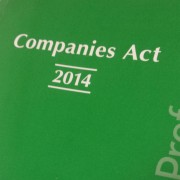CHARITIES ACT 2009
Duties and Liability of Charitable Trustees
The Charities Act 2009 (“the Act”) was, according to its Explanatory Memorandum, introduced to “ensure greater accountability and to protect against abuse of charitable status and greed”. One of the means by which the Act achieves this objective is through the introduction of a number of new obligations for trustees of charitable trusts and a general tightening up of the administration of charitable bodies. However, it is important to note that the case law of the Courts of Chancery has long imposed onerous obligations on trustees, including charity trustees which will continue to apply under the regime established by the 2009 Act.
Definition of Charity Trustee
Section 2 of the 2009 Act states that:-
“Charity Trustee” includes –
(a) In the case of a charitable organisation that is a company, the directors and other officers of the company; and
(b) in the case of a charitable organisation that is a body corporate (other than a company) or an unincorporated body of persons, any officer of the body or any person for the time being performing the functions of an officer of the body, and references to a charity trustee of a charitable organisation shall be construed as including references to a Trustees of a Charitable Trust;…”
It can be seen that the definition goes beyond persons formally appointed to the role of trustee under a deed or instrument of trust (or indeed by other means such as an order of court).
In particular, in cases where the charity is a company, it includes all of the officers of that company whether or not they have been formally appointed as trustees. In the case of charities which are not registered as companies, the definition extends to any person acting for the time being as officers of charities. Thus, even if such persons have not been formally appointed as trustee, these de facto officers are now deemed to be trustees as a matter of law.
In summary, the new statutory definition of “charity trustee” is important in its clarification of the categories of persons subject to the duties and liabilities imposed by other provisions of the 2009 Act.
General duties of Trustees
In order to understand the new duties imposed under the 2009 Act in their context, it is necessary to first understand the existing general duties imposed on all trustees.
Upon appointment the first duty of a trustee is to acquaint himself/herself with the terms of the trust under which he/she acts and the trustee must ascertain the nature and extent of the property in the trust.
It follows that the trustee must also, in the exercise of his/her duties, constantly conform to and carry out the terms of the trust. The trustee, as a prudent person of business, must take care and safeguard the property of the trust; this forms part of the duty of proper management of the trust fund.
Following on from the duty to protect the trust property, in appropriate cases, trustees may have a duty to institute legal proceedings to secure or recover the trust property. In a similar vein, the trustee must only invest in a proper manner and, in particular, in all investment, must observe to the letter both the provisions of the trust and the requirements of the law.
Trustees have a duty to keep information in relation to the trust and to give the persons beneficially interested in the trust full and accurate information as to the state of the trust fund, including accounts.
Trustees also have a duty to co-operate, and consult, with their co-trustees in a reasonable manner in all matters connected with the trust.
Trustees must not make a personal profit out of the trust business.
Of course, many of these duties – such as the duty not to make a personal profit out of the trust – reflect a trustee’s overarching duty to act in good faith, reasonably and responsibly in the interest of the trust. Although very few of these duties have been codified in the 2009 Act, they continue to apply to charity trustees with the same force alongside the new statutory duties imposed by the 2009 Act.
Duties of Trustees Imposed by the 2009 Act
While the new duties may be considered to be limited in nature (being, in some cases, a codification or at least clarification of existing duties) they are of considerable practical significance for charity trustees. Moreover, the regime established under the 2009 Act is likely to have broader implications for supervision of trustees’ duties. In this regard, it is important to note that the second general function of the Charities Regulatory Authority listed under section 14(1) of the Act is to “promote compliance by charity trustees with their duties in the control and management of charitable trusts and charitable organisations”.
Duty to Apply for Registration of a Charity
Under section 39(3) of the Act provides that it is the duty of the charity trustees to make the application for registration of the charitable organisation with the Charities Regulatory Authority (“the Authority”).
Under section 40 of the Act, charitable organisations entitled to an exemption under Section 207 or 208 of the Taxes Consolidation Act 1997 or which have a CHY number for the purposes of such an exemption, shall be deemed to be registered in the Charities Regulatory Authority “for so long only as there continues to be an entitlement to such exemption”. However, under section 40(4) of the Act, the Authority may require the charitable organisation to provide similar information to the CRA to that required under section 39.
Duty to Keep Proper Books of Account
Although trustees were already under a duty to keep proper information in relation to the trust, section 47 of the 2009 Act now imposes an express statutory duty on charity trustees to keep, or cause to be kept, on an ongoing basis proper books of account. Such accounts should give a true and fair view of the state of affairs of the charitable organisation and explain its transactions.
Duty to Maintain Annual Statement of Accounts
The charity trustees are required to prepare an “annual statement of accounts” in such form and containing such information as may be prescribed by regulations made by the Minister, albeit with certain de minimis thresholds. Section 48(3)(a) provides that, for charities with a gross income or expenditure which does not exceed €100,000, an income and expenditure account together with a statement of assets and liabilities may be submitted instead of a statement of account. Section 48(6) provides that the section does not apply to certain charities: those which are companies (a); education bodies or prescribed centres of education ((b) and (d)); and charities the gross annual income and expenditure of which does not exceed €10,000 or such greater amount (not exceeding €50,000) as may be prescribed.
Duty to Submit an Annual Report to the CRA
Section 52 of the Charities Act requires the charity trustees to submit an “annual report” in respect of its activities to the Authority not later than 10 months after the end of each financial year (or such longer period that the Authority may specify).
“Whistleblowing” Duty
There is an important provision which might be described as imposing a “whistleblowing” duty on charity trustees. Where information comes into the possession of a “relevant person” – defined to include an auditor or charity trustee – that causes him or her to form the opinion that there are “reasonable grounds for believing” that an offence has been committed under the Criminal Justice (Theft and Fraud Offences) Act 2001, the relevant person shall “as soon as may be notify the Authority in writing of that opinion and provide the Authority with a report in writing of the particulars of the grounds upon which the opinion was formed”.
Personal Liability
If a trustee fails to fulfil the duties imposed by law, the trustee may be found to be in breach of trust. For example, a trustee will generally be found liable if funds have been misappropriated or applied for an improper purpose.
While the Act imposes a number of onerous new obligations on trustees, it also protects trustees’ positions in certain respects. For example, in the case of a trustee who, despite his or her own best efforts, runs into difficulty, section 90 of the Act confers on the courts the power to grant relief from liability for breach of trust.
This section reflects the common law position as set out by Mr. Justice Keane, and provides that, where a trustee has acted honestly or reasonably, they may, notwithstanding a breach of trust, be excused from the breach in whole or in part.
Liabilities – Specific Offences
It is important to note that the Charities Act 2009 creates a number of offences which directly affect the position of charity trustees. These include:-
- It is an offence for a charity trustee to knowingly or recklessly provide information or particulars to the Authority that are false or misleading.
- It is an offence to advertise, invite members of the public to give money to, and to accept money on behalf of, a charitable organisation which is not registered or deemed to be registered.
- Where a charitable organisation changes its name in contravention of section 42(2) of the Act, the charity trustees of the organisation shall each be guilty of an offence;
- It is an offence for any person to hold out that a body, which is not registered, is registered under the Act. This extends to holding out that a body has a seat of management inside the State when it is in fact outside the State;
- It is an offence for a charity trustee to contravene the duty to keep proper books of account under section 47;
- It is an offence for a charity trustee to contravene the duty to furnish an annual statement of accounts under section 48;
- It is an offence for a charity trustee to contravene the audit requirements under section 50 where these are applicable, or to obstruct or fail to cooperate with a qualified person appointed by the Authority to carry out an audit of accounts, or to fail to comply with a direction from the Authority requiring the auditing of accounts;
- It is an offence for a charitable organisation not to submit an annual report in accordance with section 52 of the Act, of which each charity trustee can be guilty.
- It is an offence to fail to comply with a direction of the Authority under section 41(2) to afford an auditor or independent person appointed by the Authority with any facility to which they are entitled to under the relevant regulations;
- Charity trustees who act or purport to act in that capacity while disqualified under section 55 of the Act will be guilty of an offence. In addition, charity trustees (and indeed members of staff of charitable organisations) who comply with directions of persons, who act as charity trustees of the organisation but are not qualified to so act by virtue of section 55 of the Act, will themselves be guilty of an offence where they knew or had reasonable grounds for knowing that the person who gave the direction was not qualified to hold the position of charity trustee.
What is notable about a number of these offences – particularly those reflecting the new statutory duties on trustees – is that, in case of contravention, each trustee is held liable even if a particular trustee had no direct involvement in the conduct complained of; in other cases, liability extends to members of staff. The effects of this broad imposition of liability is mitigated by the defence which is expressly provided for in a number of cases under the Act, where a trustee can prove “that he or she believed on reasonable grounds that a competent and reliable person (other than the defendant) was duly charged with the duty of ensuring compliance with this section and was in a position to discharge that duty”. Nevertheless, these provisions have potentially far-reaching implications for the work of charitable organisations and highlight the importance of engaging appropriate professional advisers.
Disqualification of Trustees of a Charitable Organisation
Section 55 of the Act lists certain categories of persons who shall be disqualified from acting as a charity trustee and is in the following terms:
“A person shall cease to be qualified for, and cease to hold, the position of Charity Trustee of a charitable organisation if that person –
(a) is adjudged bankrupt,
(b) makes a composition or arrangement with creditors,
(c) is a company that is in the course of being wound up,
(d) is convicted on indictment of an offence,
(e) is sentenced to a term of imprisonment by a Court of competent jurisdiction,
(f) is the subject of an Order under Section 160 of the Companies Act 1990 or is prohibited, removed or suspended from being a Trustee of a scheme under the Pensions Acts 1990-2008,
(g) has been removed from the position of Charity Trustee of a charitable organisation by an Order of the High Court under Section 74.”
The consequences of a charity trustee ceasing to be qualified can be extremely significant for the charity itself. In particular, it is open to the Authority to apply to the High Court for an Order authorising the Authority to remove the charitable organisation from the Register.
For members of staff of the charity or other charity trustees who comply with the directions of a disqualified trustee, this may give rise to criminal liability if they had reasonable grounds for knowing this as well as civil liability for debts incurred as a result of such compliance.
Disqualified persons who continue to act are guilty of an offence and may be personally liable for any debts incurred as a result of the commission of acts in purported performance of the duties of trustee. A disqualified trustee may also be liable to repay to the Charity any remuneration, expenses or benefit in kind received for acting as a Charity Trustee. Notwithstanding disqualification, it is possible to apply to the High Court for an order that the disqualified person may hold the position of charity trustee, an order which the Court may grant if it considers this to be in the public interest and in the best interests of the charity concerned.
Indemnity Insurance for Trustees
Given the very onerous nature of the charity trustees’ roles, responsibilities and potential liabilities under the Act and the general law, all will welcome the terms of section 91 of the Charities Act. The provision is somewhat convoluted but essentially provides a practical mechanism through which charities can underwrite the cost of trustees taking out indemnity insurance in their capacity as trustees. It allows charities to enter agreements to pay trustees certain sums for this purpose. The trustees in turn undertake to pay such sums to the insurer. The insurance is “to indemnify the charity trustee in respect of any liability of the charity trustee to pay any damages or other sum to a person in respect of any act done or omitted to be done by the charity trustee in good faith and in the performance of his or her functions as charity trustee.” This will presumably allow charity trustees take out cover for the costs of investigations, damages, or to make good losses incurred in good faith and as such is a welcome addition. In a practical way, it goes some way towards limiting the personal financial exposure of persons taking on the onerous role of charity trustee.
Conclusion
The 2009 Act does change the playing field for charity trustees. While many of the core duties on trustees remain founded on the case law, the new statutory duties are significant and many of the new duties give form and substance to the more general duty of “proper management”. On a more general level, charity trustees will now be acting in a changed regulatory environment in which the Charities Regulatory Authority is entrusted with the function of promoting “compliance by charity trustees with their duties in the control and management of charitable trusts and charitable organisation”. It is clear that all charities have to adapt to this regulatory environment and that it is more important than ever for charity trustees to be aware of, and to be proactive in the exercise of, their onerous duties.
Disclaimer
This article has been prepared for general information and as such does not purport to provide legal advice. O’Connor Solicitors accept no responsibility for losses that may arise from reliance on information contained in this article. It is intended to identify general issues on which you may require legal advice. Full legal advice should be taken from a suitably qualified professional when dealing with particular circumstances.




